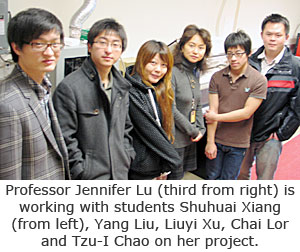

An iPod that replenishes its own energy while you walk. A pacemaker that powers itself by way of a patient’s own beating heart. A motion sensor that operates without a battery or external power source of any kind.
Those are just a few of the potential real-world applications that could come forth from the
researchbeing done by
Jennifer Lu, an
engineeringprofessor at UC Merced, who’s taking the university’s core principle of
sustainabilityand applying it on a tiny scale.
With a team of five students and a recent grant from the Department of Defense’s Defense Advanced Research Projects Agency (DARPA), Lu is working to create a three-dimensional piece of nanotechnology that will take mechanical and vibration energy and convert and store it to power small devices.
“If you can harvest the thermal and mechanical energy generated by household appliances, acoustics, environmental vibration and muscle movement, that energy can be used to power any number of small devices,” Lu said. “Then you don’t need to use electricity anymore.”
Lu said the reason for Department of Defense’s interest in such work is obvious. Around 60 percent of the devices soldiers use run on batteries. If those devices instead ran on their own power supply, the cost and inconvenience of using batteries could be eliminated.
In the pacemaker example, the beating of the heart would cause the tiny beams in the device to bend. The strain created by that bending would then be transformed into energy that could be stored and used to power the pacemaker.
Using incomprehensibly small materials to generate energy is not a new concept, but Lu said existing technology does not convert energy at a high enough rate to be effective. Her three-dimensional device would feature an array of nanoscale cantilevers, rather than the single rod used in 1D devices. That will allow it to convert energy at a much higher percentage.
“We want to use it for cell phones or nanodevices,” said Chai Lor, a 22-year-old
graduate studenton Lu’s research team. “It would be like a chip. It acts like a battery, but it’s generating its own energy.”
Lu was one of just 33 researchers to receive the 2009 DARPA Young Faculty Award late last year and one of just 96 in the program’s history. The awardees receive their grants over a two-year period, allowing them to develop and validate their research ideas.
While Lu’s project might be completed within those two years, she knows it will be much longer before we’ll see the results in practice. Still, she’s hopeful it won’t be too long before heart-powered pacemakers and self-powered iPods become a reality.
“It just depends on the effort and the commitment of the people working on the technology,” Lu said. “I think it will happen in the foreseeable future.”






